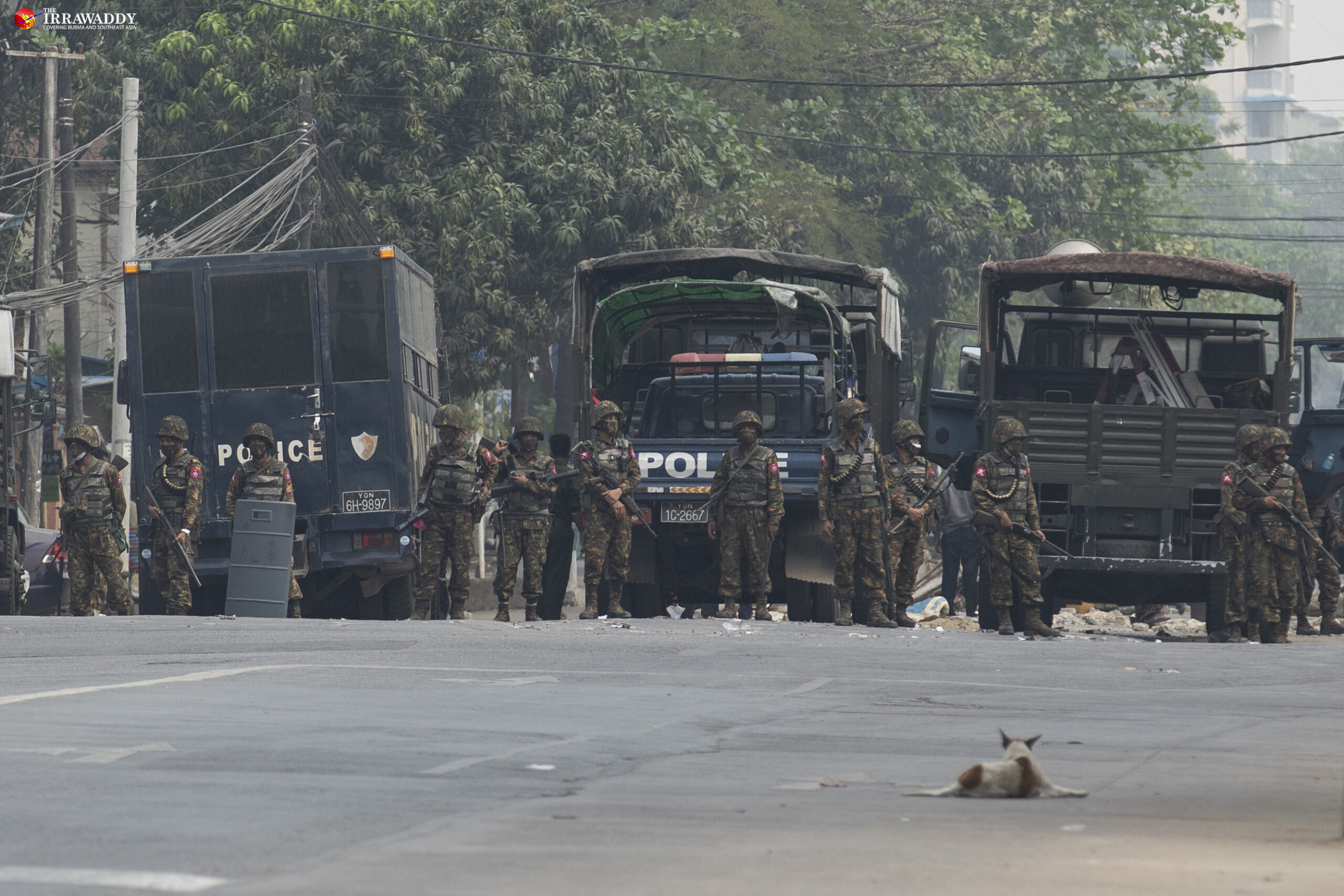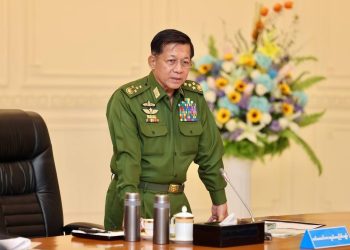The decision by Myanmar’s National Unity Government (NUG) to declare a “defensive people’s war” against the military junta that usurped power in Naypyitaw on Feb. 1 has not been met with much sympathy from the international community. The British ambassador designate to Myanmar, Pete Vowles, tweeted on Sept. 7 that his country “supports peaceful efforts to restore democracy in Myanmar. We strongly condemn the coup’s coup and brutality, we call on all parties to engage in dialogue.”
Two days later, The Irrawaddy quoted the US Embassy in Yangon as stating that they encourage “all sides to be peaceful and to avoid an escalation of violence.” Chris Sidoti, a member of the Special Advisory Council for Myanmar, an independent group of international experts, told Reuters on Sept. 8 that “Violence is the cause of the suffering of the people of Myanmar, it is not the solution…We empathize with the NUG, but we fear for what will happen as a result of this decision.”
ASEAN has proposed a four-month ceasefire to enable the delivery of humanitarian aid and is also encouraging a dialogue between the junta, the State Administration Council (SAC), and its opponents. The Australian government, which before the coup had a bilateral Defense Cooperation Program with the Tatmadaw (Myanmar’s military), has repeatedly urged the SAC to engage in a dialogue and somehow believes that ASEAN can play a constructive role in solving the crisis in Myanmar.
No one in his or her right mind would be against a dialogue leading to a peaceful solution to Myanmar’s escalating civil wars between the Tatmadaw and the ethnic armed organizations and now also a host of new resistance armies which are active not in border areas but in the country’s heartland. But it is recklessly naïve to believe that the Tatmadaw, with or without foreign encouragement, would be even remotely interested in engaging in such a dialogue. Exchanging views and reaching compromises have never been on the generals’ agenda. They have always believed in military might and demanded surrender from their opponents. But if a peaceful solution to Myanmar’s many conflicts is not possible, what’s the alternative? Does the NUG and its armed wing, the loosely organized People’s Defense Force (PDF), and its ethnic allies have any chance of defeating the mighty Tatmadaw?

As all the readers of The Irrawaddy are aware, I’ve been writing about Myanmar’s civil war for more than four decades. During that time, I have also on numerous occasions seen the Tatmadaw in action and also been in the middle of two major battles in the frontier areas. The first was in the Naga Hills in December 1985 when the Tatmadaw launched an early morning attack on the headquarters of the National Socialist Council of Nagaland in northwestern Sagaing Region (then Division). It is quite possible that my presence there was a major reason why the Tatmadaw decided to move troops across those remote and rugged hills and attack. The battle was fierce because troops from the Kachin Independence Army (KIA) were there, and that made a difference from fighting the poorly armed Naga. But, in the end, the Tatmadaw captured the camp. I and other survivors had to flee and hide in the jungle for days before it was possible to move to more secure locations.
The second time was at the battle of Hsi-Hsinwan in northern Shan State in November 1986. I was in a trench together with commanders of the Communist Party of Burma (CPB) when their “people’s army” attacked a Tatmadaw position on the top of the mountain. Hundreds of CPB soldiers had been mobilized for the fight, which began at dawn. I have never seen such an arsenal anywhere in Myanmar’s war-torn areas. The CPB’s troops were equipped with 120mm mortars, 75mm recoilless rifles, grenade launchers, machine-guns and automatic rifles.
The Tatmadaw camp was blown to pieces and casualties were severe, but the few surviving troops refused to surrender. I did, though, meet a wounded soldier who had been captured by the CPB. I had witnessed the fight from the CPB’s side, but, as I wrote about the encounter in my book Land of Jade: “I was disappointed at not being able to interview him. I would at least have liked to tell him that I had been impressed by the fighting spirit of his unit.”
In those days, the Tatmadaw was also an extremely brutal force committing numerous and often unspeakable atrocities on the civilian population in the frontier areas. I had learned that from many interviews with villagers and other victims of Tatmadaw cruelty. At the same time, it was actually quite poorly armed — but, despite all that, a battle-hardened and largely effective light infantry force. Soldiers were constantly on the move and there were fights against the CPB, the Karen on the Thai border, the Kachin in the far north and other pockets of resistance in ethnic minority areas.
All that changed after the 1988 pro-democracy uprising. The main fear within the Tatmadaw leadership was that disgruntled soldiers might join the pro-democracy activists and that, in turn, would be the beginning of the end of military-dominated rule in Myanmar. Consequently, in order to prevent a crack in the ranks, everything was done to keep at least the officer corps satisfied. Beginning in 1989, the Tatmadaw spent more than a billion dollars on procuring new, more sophisticated military equipment. It came primarily from China but also from Singapore, Pakistan and Israel. Most of it, however, was materiel that Myanmar did not actually need, such as missile systems that would be of little use in counter-insurgency operations, huge tanks, armored vehicles, naval patrol boats and various kinds of radar equipment. It was simply toys for the boys and the troops also got new, smart uniforms. Before long, Myanmar’s own defense industries began producing new infantry rifles to replace the old, heavy G-3 which was based on German designs.
Equally important was a decision to scrap the previous, unpopular system of constant rotations of regional commanders, which had been done in order to make sure that no such officer built up his own power base in a certain part of the country. And then came a series of ceasefire agreements between the Tatmadaw and a number of ethnic rebel armies. The Wa, the Kachin, Khun Sa’s drug army, the Mon and Pa-O and others made peace with the Tatmadaw. Those agreements, initiated by intelligence chief Gen. Khin Nyunt, were struck in order to prevent a link-up between the urban dissidents and the ethnic rebels, which could have proven disastrous for the junta that took over power on Sept. 18, 1988. It worked. Only a few pro-democracy activists remained with the Karen National Union, the only sizable ethnic army that refused to enter into a truce with the Tatmadaw.
But, to be on the safe side, the size of the Tatmadaw was increased dramatically. The three services — the army, the air force and the navy — amounted to no more than 195,000 men before 1988. Nearly all of them belonged to the army; the air force as well as the navy were very small and, many would argue, almost insignificant. According to the London-based International Institute for Strategic Studies and other international think-tanks, the army has now 507,000 men, the air force 23,000 and the navy 19,000, so altogether 549,000 in total. Those think-tanks may have grossly overestimated the strength of the Tatmadaw because most units are undermanned and many troops may exist only in official reports from the field.
Be that as it may, it is undeniable that the strength of the Tatmadaw in terms of manpower and equipment is way above that of the 1980s. But, because of the old ceasefire agreements, which lasted for nearly two decades, that also means that a generation of troops have very limited fighting experience. They are, as a source said, better at parades showing off their new uniforms and guns than at combat. And then, the embrace of the market economy that followed the 1988 uprising gave the officers ample opportunities to earn vast amounts of money. As one Myanmar source wrote on social media: “the army officers are only interested in taking bribes and making business deals with the cronies, they don’t want to fight battles anymore, they joined the army to get rich quickly.” Or, as a retired Tatmadaw officer once told me: “luxury when I was in the army consisted of a badminton set and a bottle of army rum, and I was a colonel. Now even captains and lieutenants have more than one car, several sets of golf clubs, and at least two mistresses. And they don’t have to fight.”
That changed again when, in June 2011, the ceasefire with the KIA broke down. For the first time in more than a decade, major battles raged in an ethnic minority area. I was at the KIA headquarters in Laiza in December 2012 and I was astonished to observe the poor performance of the Tatmadaw. In the beginning, they sent in the infantry, which was poorly trained and had zero fighting experience. Casualties were extremely heavy as the advancing Tatmadaw troops were mowed down by KIA guerrillas. It became so bad that the Tatmadaw had to withdraw its infantry and rely instead on its Russian-supplied helicopter gunships, attack aircraft and heavy artillery fired from bases far from the KIA’s positions. According to credible reports from Yangon at the time, some officers paid bribes to avoid being sent to Kachin State to fight. This was not the Tatmadaw I saw in the 1980s.
Then came another fierce war in Rakhine State as a new rebel force, the Arakan Army (AA), rose up in arms. Tatmadaw dead and wounded numbered in the thousands, including some senior officers. And, again, the infantry’s poor performance prompted the Tatmadaw to resort to air power, firing indiscriminately into villages where they thought the AA would be present — but to no avail. Today, the AA and its civilian wing run a de facto parallel government in Rakhine State. The AA is closely allied with the Ta’ang National Liberation Army, a Palaung force, and the Myanmar National Democratic Alliance Army, which is made up of fighters from Kokang, an area in northeastern Shan State dominated by ethnic Chinese. Judging from independent reports, those three armies, called the Brotherhood Alliance, have fought what appear to be numerous successful battles with the Tatmadaw. According to a November 2020 paper published by the United States Institute of Peace, “Myanmar has not experienced this intensity of fighting in decades.” Nor has it suffered such heavy casualties.
The big question now is: What’s next? Today, the Burmese-dominated Tatmadaw is sent out to gun down people not only from the ethnic minorities but also their own kin in parts of the country where there has been no insurgency since the years immediately after independence in 1948. That, and the casualties they are evidently suffering even there, must have a devastating effect on the morale of the troops. For the first time in decades, there are now speculations about possible rifts within the Tatmadaw. If NUG sources are to be believed, more than 2,000 security personnel, most of them policemen but also soldiers, have defected to the pro-democracy movement.
None of those reports can be independently verified, but it is clear that something that has never happened before is brewing within the Tatmadaw. It remains to be seen whether the NUG’s “defensive people’s war” will accelerate that process — or have the opposite effect, namely to make the Tatmadaw close ranks even more firmly than before. A main problem is that many officers and even private soldiers must be acutely aware of what they have done when it comes to corrupt practices and atrocities they have committed. They may fear that a change could mean that they would be held accountable for all that — and the brutality that the Tatmadaw now has unleashed in towns and villages all over the country is almost unprecedented.
What began as carnival-style protests immediately after the coup became something entirely different when the police and the Tatmadaw began killing peaceful protesters. Such brutality breeds resistance, and that is what we are seeing in Myanmar today. In any case and whatever the future will be, forget about “dialogues” and futile attempts at urging the two sides to refrain from violence.
You may also like these stories:
The Revolt Against Myanmar’s Junta Can Succeed
Myanmar Needs ‘People First’ Assistanc
The Rise and Fall of America’s Muscular Humanitarianism in Myanmar
















